Alger County
Click on the sites below and explore Alger County!
Alger County Heritage Center
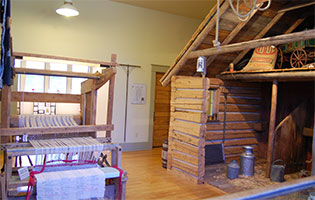 The Heritage Center was opened by the Alger County Historical Society in 1993 in what used to be Washington Grade School. Local history and exhibits that are displayed in the Center range on topics from Native Americans, fur-traders, lumbering, resort, lake, and manufacturing history. The Center has exhibits specifically on Grand Island's Hotel Williams, the game ranch and the Munising Woodenware Factory. There is also a blacksmith shop housing artifacts and every month a living history presentation. Also on the Center grounds is the American Fur Company log cabin #3, which was moved from Grand Island. This cabin, along with four others, was occupied by one of the first Euro-American settlers to the Munising area, Abraham W. Williams, shortly after its abandonment by the American Fur Company in July 1840. Williams became a store-keeper, serving the Native Americans and Euro-American settlers in the surrounding area. After the Historical Society moved it onto the grounds of the Heritage Center, it was restored and now houses artifacts from the fur trade and some of Williams' own possessions.
The Heritage Center was opened by the Alger County Historical Society in 1993 in what used to be Washington Grade School. Local history and exhibits that are displayed in the Center range on topics from Native Americans, fur-traders, lumbering, resort, lake, and manufacturing history. The Center has exhibits specifically on Grand Island's Hotel Williams, the game ranch and the Munising Woodenware Factory. There is also a blacksmith shop housing artifacts and every month a living history presentation. Also on the Center grounds is the American Fur Company log cabin #3, which was moved from Grand Island. This cabin, along with four others, was occupied by one of the first Euro-American settlers to the Munising area, Abraham W. Williams, shortly after its abandonment by the American Fur Company in July 1840. Williams became a store-keeper, serving the Native Americans and Euro-American settlers in the surrounding area. After the Historical Society moved it onto the grounds of the Heritage Center, it was restored and now houses artifacts from the fur trade and some of Williams' own possessions.
Additional Information
The Heritage Center is located at 1496 Washington St. in Munising, Michigan.
View MapThe Heritage Center is open Tuesday through Saturday 12:00pm to 3:00pm, year round. For more information on the Alger County Historical Center, go to their website.
Alger Underwater Preserve
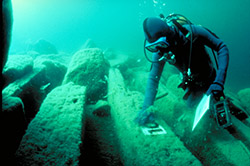 The Alger Underwater Preserve stretches from just west of Munising to Au Sable Point, this stretch includes the Pictured Rocks National Lakeshore. The Preserve contains many shipwrecks from the late 1800s and early 1900s when the Upper Peninsula Iron Ranges were shipping out vast amounts of Iron from the Western part of the Peninsula through the St. Mary's Canal at Sault Saint Marie. This journey could be dangerous due to the harsh unpredictable storms on Lake Superior. The waters near Munising, sheltered by Grand Island, were one of the safe havens for ships. These waters are littered with wrecked ships that could not reach safety before the storm struck. Many of these wrecks, along with an underwater museum, can now be explored by scuba dive or glass bottom boat tours.
The Alger Underwater Preserve stretches from just west of Munising to Au Sable Point, this stretch includes the Pictured Rocks National Lakeshore. The Preserve contains many shipwrecks from the late 1800s and early 1900s when the Upper Peninsula Iron Ranges were shipping out vast amounts of Iron from the Western part of the Peninsula through the St. Mary's Canal at Sault Saint Marie. This journey could be dangerous due to the harsh unpredictable storms on Lake Superior. The waters near Munising, sheltered by Grand Island, were one of the safe havens for ships. These waters are littered with wrecked ships that could not reach safety before the storm struck. Many of these wrecks, along with an underwater museum, can now be explored by scuba dive or glass bottom boat tours.
Additional Information
The Alger Underwater Preserve stretches from just west of Munising to Au Sable Point, this stretch includes the Pictured Rocks National Lakeshore.
View MapThe tours of the Underwater Preserve begin in Munising, Michigan. Tours can be taken during the summer months. For more information on the Alger Underwater Preserve, go to their website.
Au Sable Point Lighthouse
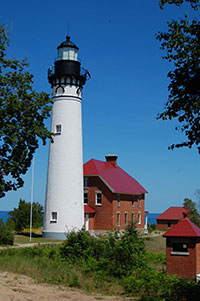 The Au Sable Point Lighthouse was completed in 1874. It was placed on Au Sable Point due to the dangerous waters in the area between the Whitefish Point and Grand Island Lighthouses. The Light Station comprises five significant buildings: a light tower, two homes, a fog signal house, and a boat house along with four extra buildings. The tower is eighty-seven feet tall and constructed of brick. A Third-Order Fresnel Lens displayed a fixed white light. The attached Keeper's house was two stories tall. The Coast Guard automated the light in 1958, later turning the property and buildings over to the National Park Service to be included in the Pictured Rocks National Lakeshore. The Light is now solar powered and still in use. Though the Fresnel Lens was removed, it can still be seen in the lens room in the light tower.
The Au Sable Point Lighthouse was completed in 1874. It was placed on Au Sable Point due to the dangerous waters in the area between the Whitefish Point and Grand Island Lighthouses. The Light Station comprises five significant buildings: a light tower, two homes, a fog signal house, and a boat house along with four extra buildings. The tower is eighty-seven feet tall and constructed of brick. A Third-Order Fresnel Lens displayed a fixed white light. The attached Keeper's house was two stories tall. The Coast Guard automated the light in 1958, later turning the property and buildings over to the National Park Service to be included in the Pictured Rocks National Lakeshore. The Light is now solar powered and still in use. Though the Fresnel Lens was removed, it can still be seen in the lens room in the light tower.
Additional Information
The Lighthouse is accessed after a one and a half mile walk (one way) east of the lower Hurricane River Campground. The Hurricane River Campground is twelve miles west of Grand Marais on Alger County road H-58.
View MapThe Lighthouse is open June 10 through September 15 (as staffing permits) on Wednesdays through Sundays. Tours begin at 11:00 am and run through 5:00 pm. There are no tours on Mondays and Tuesdays. For more information on the Au Sable Point Lighthouse, go to their website.
Bay Furnace
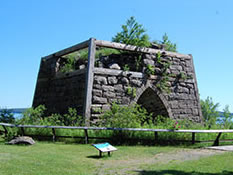 Bay Furnace stack Number One was constructed in 1870 as part of a small settlement, called Onota, to smelt iron ore from the Marquette Iron Range. It constructed of rock from a quarry near Powell's Point and was forty-five feet high, with hot blast and boilers at the top. By 1874, Number One was producing fifteen tons of pig iron per day. The profits of this furnace started a settlement and building activity. A second stack was built due to demand in 1872. Number Two was discontinued after one year for repairs. The iron produced by the company was mainly used for Bessemer rails, car wheels, stoves, and small domestic items made of iron. The furnace had a short lifespan, however. Bay Furnace closed when a fire burned through the furnace and town in 1877, destroying everything. Due to the decline of profitable pig iron, the town was never rebuilt, and the machinery was moved to Iron River. The Bay Furnace can still be seen in its ruined state, it is about half of the original height and shares a distinction with Fayette State Park furnaces as the only remaining furnace accessible to the public from the U.P. iron smelting era.
Bay Furnace stack Number One was constructed in 1870 as part of a small settlement, called Onota, to smelt iron ore from the Marquette Iron Range. It constructed of rock from a quarry near Powell's Point and was forty-five feet high, with hot blast and boilers at the top. By 1874, Number One was producing fifteen tons of pig iron per day. The profits of this furnace started a settlement and building activity. A second stack was built due to demand in 1872. Number Two was discontinued after one year for repairs. The iron produced by the company was mainly used for Bessemer rails, car wheels, stoves, and small domestic items made of iron. The furnace had a short lifespan, however. Bay Furnace closed when a fire burned through the furnace and town in 1877, destroying everything. Due to the decline of profitable pig iron, the town was never rebuilt, and the machinery was moved to Iron River. The Bay Furnace can still be seen in its ruined state, it is about half of the original height and shares a distinction with Fayette State Park furnaces as the only remaining furnace accessible to the public from the U.P. iron smelting era.
Additional Information
Bay Furnace is located 5 miles west of Munising on M-28, on the south shore of Lake Superior, at Christmas in the Hiawatha State Forest.
View Map
Gitche Gumme Agate and Historical Museum
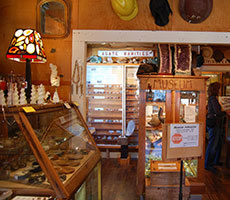 The Gitche Gumme Agate and Historical Museum was founded by Axel Niemi, who, for around 25 years, entertained people with his music, stories, and knowledge about rocks and minerals. The museum was purchased from Axel by a close friend, Ronald Marshall, in 1990. Ronald made some repairs to the building over the next few years. In 1998, Ronald sold the museum to its current owner, Karen Brzys. That same year the building was completely redone. The Niemi family's collection of history items from the area were displayed for the first time, and the mineral collection grew. The museum was reopened in 1999, after being closed for about 21 years. The Museum showcases the local history of Grand Marais, including the town's once booming lumbering and fishing industries, along with a beautiful collection of agates and other minerals from the Upper Michigan region.
The Gitche Gumme Agate and Historical Museum was founded by Axel Niemi, who, for around 25 years, entertained people with his music, stories, and knowledge about rocks and minerals. The museum was purchased from Axel by a close friend, Ronald Marshall, in 1990. Ronald made some repairs to the building over the next few years. In 1998, Ronald sold the museum to its current owner, Karen Brzys. That same year the building was completely redone. The Niemi family's collection of history items from the area were displayed for the first time, and the mineral collection grew. The museum was reopened in 1999, after being closed for about 21 years. The Museum showcases the local history of Grand Marais, including the town's once booming lumbering and fishing industries, along with a beautiful collection of agates and other minerals from the Upper Michigan region.
Additional Information
The Gitche Gumme Museum is located in Grand Marais at E21739 Brazel Street.
View MapThe Museum is open daily from May through September, though hours vary by month or week. The Museum is open by appointment only from October through May, though a donation or purchase is requested. To confirm open hours either visit the Museum webpage or call 906-494-3000 or 906-494-2590. For more information on the Gitche Gumme Museum, go to their website.
Grand Island
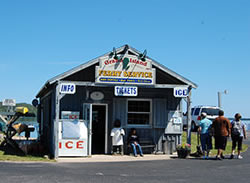 Over 3,000 years ago, Native Americans hunted on and fished off of Grand Island, a 13,500-acre island in Munising Bay. In the mid-seventeenth century, Grand Island was first described by Europeans who were exploring the Great Lakes region; the island was later surveyed by Lewis and Clark. In the early 1800s, American Fur Company traders, employed by John Jacob Astor, built small log cabins close to Native American settlements on the island for trading purposes. When the traders left in the 1840s, Abraham Williams and his family settled on the island, taking over four abandoned cabins and continuing trade with Native Americans and other Euro-American settlers. From 1904 until 1989, Grand Island was owned by the Cleveland Cliffs Iron Company of Ishpeming and Cleveland, Ohio. William Mather, the company president, used the island as a hunting retreat, game ranch, and resort. During his lifetime, he protected the old growth trees from the loggers. Shortly after Mather died in 1951, large scale logging started and continued on the island. In 1984, Grand Island was put on the real estate market. It was purchased in 1989 by a private non-profit group. The island was soon purchased by the Federal Government, and, in 1990, became included in the Hiawatha National Forest. There is also some private land on the island. There are also two light stations on the island: Grand Island Harbor Rear Range Light and Grand Island North Light Station. Today, the island is used for camping, hiking, kayaking, bicycling, and other outdoor activities.
Over 3,000 years ago, Native Americans hunted on and fished off of Grand Island, a 13,500-acre island in Munising Bay. In the mid-seventeenth century, Grand Island was first described by Europeans who were exploring the Great Lakes region; the island was later surveyed by Lewis and Clark. In the early 1800s, American Fur Company traders, employed by John Jacob Astor, built small log cabins close to Native American settlements on the island for trading purposes. When the traders left in the 1840s, Abraham Williams and his family settled on the island, taking over four abandoned cabins and continuing trade with Native Americans and other Euro-American settlers. From 1904 until 1989, Grand Island was owned by the Cleveland Cliffs Iron Company of Ishpeming and Cleveland, Ohio. William Mather, the company president, used the island as a hunting retreat, game ranch, and resort. During his lifetime, he protected the old growth trees from the loggers. Shortly after Mather died in 1951, large scale logging started and continued on the island. In 1984, Grand Island was put on the real estate market. It was purchased in 1989 by a private non-profit group. The island was soon purchased by the Federal Government, and, in 1990, became included in the Hiawatha National Forest. There is also some private land on the island. There are also two light stations on the island: Grand Island Harbor Rear Range Light and Grand Island North Light Station. Today, the island is used for camping, hiking, kayaking, bicycling, and other outdoor activities.
Additional Information
Grand Island is located in Munising Bay, just outside of Munising, Michigan.
View MapThe Grand Island Ferry is open from Memorial Day Weekend through October 9. Most tours start on June 15, and go through October 5. There is only one tour from June 15 through June 30 and Labor Day through October 5. Dates between, there are two trips daily. For more information on Grand Island, go to their website.
Pacific Hotel
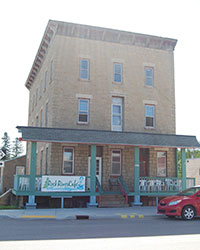 The Pacific Hotel was built in 1904 by Edward Levy, a grocery store owner and saloon keeper. The Hotel is three stories, contains twenty rooms, and was built using sandstone that was quarried from the Chatham quarry south of the town. At this time, Chatham was at the center of a thriving lumber area, bringing in many people from the logging company, sales people, and other travelers through or to the area. The Hotel has served many purposes over the years, including a temporary hospital during the 1918 Spanish Flu epidemic, a saloon, a barber shop, and an adult foster care facility. It also survived a fire in 1925. The Hotel temporarily closed in 1981, but soon reopened. Today there is a café on the ground floor.
The Pacific Hotel was built in 1904 by Edward Levy, a grocery store owner and saloon keeper. The Hotel is three stories, contains twenty rooms, and was built using sandstone that was quarried from the Chatham quarry south of the town. At this time, Chatham was at the center of a thriving lumber area, bringing in many people from the logging company, sales people, and other travelers through or to the area. The Hotel has served many purposes over the years, including a temporary hospital during the 1918 Spanish Flu epidemic, a saloon, a barber shop, and an adult foster care facility. It also survived a fire in 1925. The Hotel temporarily closed in 1981, but soon reopened. Today there is a café on the ground floor.
Additional Information
The Pacific Hotel is located at N5298 Rock River Road in Chatham, Michigan.
View MapIt is open through the year.
Paulson House
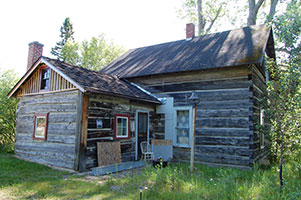 The Paulson House was built by Charles Paulson, a Swede who had previously worked as a miner in the Ishpeming-Negaunee area. The log house was built around 1884 when Charles Paulson purchased one hundred acres of land to build his new family home. Charles built the house with cedar logs, using v-notching at the corners. The house is two stories tall with three rooms on the upper floor and five rooms on the ground floor. In this home, the Charles and his wife Lena lived and raised their three daughters. Charles and Lena lived in this home until their deaths in 1925, one daughter stayed in the home until the mid-1930s, when she too died. After that the home passed through many hands, and in the 1970s many internal and external repairs were done on the house. Today, the Paulson House is a museum of pioneer life.
The Paulson House was built by Charles Paulson, a Swede who had previously worked as a miner in the Ishpeming-Negaunee area. The log house was built around 1884 when Charles Paulson purchased one hundred acres of land to build his new family home. Charles built the house with cedar logs, using v-notching at the corners. The house is two stories tall with three rooms on the upper floor and five rooms on the ground floor. In this home, the Charles and his wife Lena lived and raised their three daughters. Charles and Lena lived in this home until their deaths in 1925, one daughter stayed in the home until the mid-1930s, when she too died. After that the home passed through many hands, and in the 1970s many internal and external repairs were done on the house. Today, the Paulson House is a museum of pioneer life.
Additional Information
The Paulson House is located at N6925 Forest Lake Road, outside of Au Train, Michigan. When on M-28, turn into Au Train at the yield light and continue down the road about two and one half miles to Au Train Lake, the Paulson House is on the right.
View MapThe Paulson House is open during the Summer months from 2:00 to 5:00 in the afternoon, Sunday through Friday. For more information on the Paulson House or the Paulson Family, go to their website.
Pictured Rocks National Lakeshore
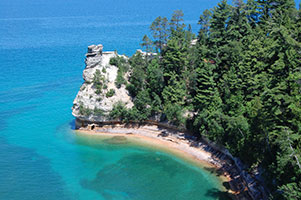 Pictured Rocks National Lakeshore is comprised of 40 miles of gorgeous lakeshore between Munising and Grand Marais. The picturesque spot on the shore of Lake Superior includes sandy beaches, pristine waters, 200 foot colorful sandstone formations, miles of hiking trails, and waterfalls to explore. From Miner's Castle to the Grand Sable Dunes, Pictured Rocks is full of amazing scenery and rich in natural beauty.
Pictured Rocks National Lakeshore is comprised of 40 miles of gorgeous lakeshore between Munising and Grand Marais. The picturesque spot on the shore of Lake Superior includes sandy beaches, pristine waters, 200 foot colorful sandstone formations, miles of hiking trails, and waterfalls to explore. From Miner's Castle to the Grand Sable Dunes, Pictured Rocks is full of amazing scenery and rich in natural beauty.
Additional Information
The Lakeshore is located on the coast of Lake Superior between Munising and Grand Marais.
View MapOne can visit the lakeshore year round, but it is advised to plan ones visit before starting out. For more information on Pictured Rocks National Lakeshore, go to their website.
Rock River Charcoal Kilns
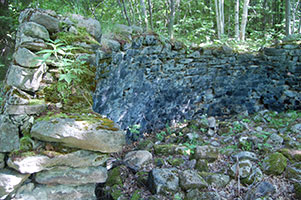 The Rock River kilns were constructed in 1882 out of local sandstone and were opened as a stop on the Detroit and Mackinac Railroad. At their peak production, in 1890, the kilns produced twenty railroad car loads of coal per month. Much of this coal was used during the iron smelting process. The kilns were in operation until 1896, when the timber in the surrounding area became depleted. The surrounding settlements of French Canadians and Swedes were abandoned by 1898. Today, the ruins of several kilns remain and are observable after a short walk.
The Rock River kilns were constructed in 1882 out of local sandstone and were opened as a stop on the Detroit and Mackinac Railroad. At their peak production, in 1890, the kilns produced twenty railroad car loads of coal per month. Much of this coal was used during the iron smelting process. The kilns were in operation until 1896, when the timber in the surrounding area became depleted. The surrounding settlements of French Canadians and Swedes were abandoned by 1898. Today, the ruins of several kilns remain and are observable after a short walk.
Additional Information
The Rock River kilns are located, from M-28 West, turn left onto Co. Highway 457, then take a sharp right onto Co. Highway 459 for 0.9 miles. The site will be on the left.
View MapThis site can be viewed all year round, but it would be best to view in the summer months.
The Lighthouse Keeper's House and Museum
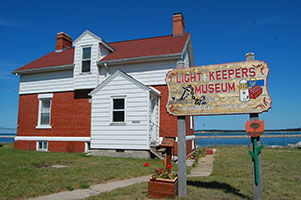 The Light Keeper's House was a brick building built in 1906 by the Life Saving Service. Prior to the construction of this home, the light keeper lived in a homemade shack made out of scrap lumber. The lighthouse inspector described it as a "miserable shanty" which may have led to the more permanent structure being built. During World War II, the Coast Guard took over the light keeper's duties, and their families lived in the house until the close of the station in 1982. The Grand Marais Historical Society received the house in 1984 and began restoring the home. The museum now contains items which were used in the 1900s.
The Light Keeper's House was a brick building built in 1906 by the Life Saving Service. Prior to the construction of this home, the light keeper lived in a homemade shack made out of scrap lumber. The lighthouse inspector described it as a "miserable shanty" which may have led to the more permanent structure being built. During World War II, the Coast Guard took over the light keeper's duties, and their families lived in the house until the close of the station in 1982. The Grand Marais Historical Society received the house in 1984 and began restoring the home. The museum now contains items which were used in the 1900s.
Additional Information
The Lighthouse Keeper's House and Museum is located in Grand Marais, at the end of Coast Guard Point overlooking the channel.
The House is open in July and August daily from 1:00pm to 4:00pm. In June and September, it is open on weekends from 1:00pm to 4:00pm. For more information on the Lighthouse Keeper's House and Museum go to, their website.
The Pickle Barrel House Museum
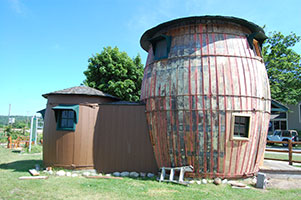 The Pickle Barrel House was built in 1926 as a summer cottage for William Donalhey and his wife, Mary. William Donalhey was an author/illustrator who drew "The Teenie Weenies" from 1912 to 1970. The cartoon of busy two inch tall people ran in the Chicago Tribune for over 50 years. The house, which contains a living area, pantry, kitchen, and bedroom, was located on the shore of Sable Lake until 1937. At that time, the house was moved into Grand Marais and placed on the corner of Lake Avenue and Randolph Street. For many years it was a visitors information center, ice cream stand, and gift shop. In 2003, the Historical Society purchased the building and restored it to its original condition as a summer cottage. When visitors walk in, its like entering the 1920s.
The Pickle Barrel House was built in 1926 as a summer cottage for William Donalhey and his wife, Mary. William Donalhey was an author/illustrator who drew "The Teenie Weenies" from 1912 to 1970. The cartoon of busy two inch tall people ran in the Chicago Tribune for over 50 years. The house, which contains a living area, pantry, kitchen, and bedroom, was located on the shore of Sable Lake until 1937. At that time, the house was moved into Grand Marais and placed on the corner of Lake Avenue and Randolph Street. For many years it was a visitors information center, ice cream stand, and gift shop. In 2003, the Historical Society purchased the building and restored it to its original condition as a summer cottage. When visitors walk in, its like entering the 1920s.
Additional Information
The Pickle Barrel House Museum is located in Grand Marais on Lake Avenue right in the middle of town.
The House is open in July and August daily from 1:00pm to 4:00pm. In June and September, it is open on weekends from 1:00pm to 4:00pm. For more information on the Pickle Barrel House Museum, go to their website.
The Old Post Office Museum
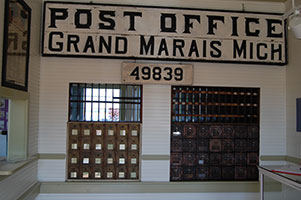 The Old Post Office was originally built around 1905 as a jewelry store. In 1907, it was added onto and began being used as a Post Office. The five sided structure served as Grand Marais's center for mail and information for around 70 years. When the Post Office changed locations in the 1970s, the building was converted into a gift shop and beauty salon. In 2007, the new owners need to move the building and so instead of tearing it down, they donated it to the Grand Marais Historical Society. The building was moved to its current location on Lake Avenue, and the Historical Society got started renovating the building. The building is now a walk through museum of Grand Marais from its earliest days to the present.
The Old Post Office was originally built around 1905 as a jewelry store. In 1907, it was added onto and began being used as a Post Office. The five sided structure served as Grand Marais's center for mail and information for around 70 years. When the Post Office changed locations in the 1970s, the building was converted into a gift shop and beauty salon. In 2007, the new owners need to move the building and so instead of tearing it down, they donated it to the Grand Marais Historical Society. The building was moved to its current location on Lake Avenue, and the Historical Society got started renovating the building. The building is now a walk through museum of Grand Marais from its earliest days to the present.
Additional Information
The Old Post Office Museum is located in Grand Marais on Lake Avenue in the middle of town.
View MapThe Post Office is open in July and August daily from 1:00pm to 4:00pm. In June and September, it is open on weekends from 1:00pm to 4:00pm. For more information on the Old Post Office Museum, go to their website.


